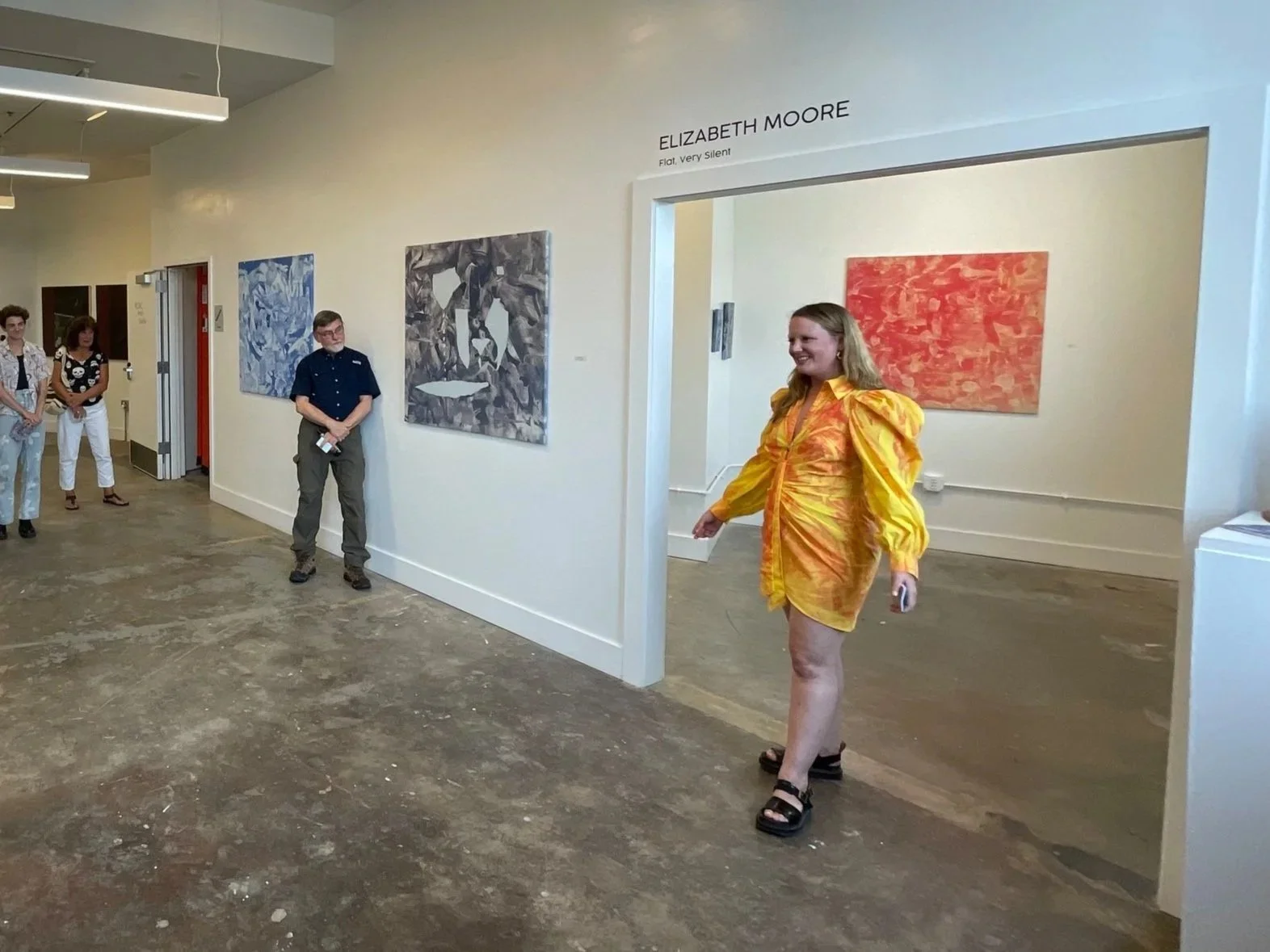2022 Exhibiting Artist, Elizabeth Moore, giving an Artist Talk for her solo exhibition, Flat, Very Silent.
Your art speaks for itself - but your words can open the door.
Every artist has a story, and sharing it helps people connect more deeply with your work. Your artist statement and bio aren’t just paperwork — they’re invitations. They give viewers a way in, helping them understand the ideas, emotions, and experiences behind what you create.
This isn’t about selling yourself. It’s about giving your audience a compass so they can navigate your work with more curiosity and connection.
-
An artist statement is a short piece of writing (usually one paragraph to one page) that explains:
What you make
How you make it
Why you make it
Think of it as a conversation opener — something you might say to a stranger who’s seeing your work for the first time.
Tips for a statement that sounds like you:
Write like you speak. Avoid jargon or overly academic language.
Use specific, sensory words. (“I layer transparent colors until the forms feel like they’re breathing” is more engaging than “I use mixed media techniques.”)
Focus on the heart of your work, not your entire life story.
-
A bio is different from a statement. It’s a short, factual summary of who you are as an artist.
It might include:Where you live and work
Your education (formal or informal)
Exhibitions, awards, or publications
A closing line about your current projects
A bio is often used in programs, websites, or exhibition labels. It’s helpful to have a few versions ready: one sentence, one short paragraph, and one longer paragraph.
-
Write down a few bullet points answering these:
What materials do I work with?
What themes, ideas, or questions inspire me?
What do I want my work to spark in others?
Turn those bullet points into a few sentences.
Read it out loud. Does it sound like you? If not, adjust until it does.
Want help? Use the Artist Statement & Bio Worksheet to get your first draft written.
More Tips for Writing Artist Statements
Artist Statement
-
Your artist statement should reflect your unique voice and artistic journey. Avoid jargon and focus on conveying your passion and intent. As the New York Foundation for the Arts (NYFA) advises, "Impress them with your art, not with your extensive knowledge of art criticism or art history."
The Community Arts Partnership in Ithaca, NY has another resource and worksheet for writing your Artists Statement, check it our here: artspartner.org
-
Aim for a concise statement that clearly communicates your artistic vision, process, and influences. The Creative Independent suggests listing adjectives that describe your work, such as "quiet," "rhythmic," or "messy," to provide specific and vivid imagery.
-
An artist statement is a living document that should evolve with your practice. The Community Arts Partnership recommends rewriting your statement whenever you complete a new body of work to ensure it accurately reflects your current artistic endeavors.
Artist Bio
-
Begin your bio with the most compelling details, such as your artistic discipline, notable achievements, and current projects. Mid-America Arts Alliance suggests front-loading your bio to capture the reader's attention immediately.
-
Write your bio in the third person and focus on factual information like education, exhibitions, and awards. Avoid personal anecdotes or overly casual language to maintain professionalism.
-
Mid-America Arts Alliance suggests you aim for a bio length of 150-200 words. This length is sufficient to highlight your key accomplishments without overwhelming the reader.
Reputable Resources for Further Guidance
The Creative Independent: Offers a comprehensive guide on writing artist statements, including prompts and examples.
Mid-America Arts Alliance: Provides a detailed PDF on crafting professional artist bios, with tips on structure and content.
NYFA (New York Foundation for the Arts): Shares dos and don'ts for writing artist statements, based on extensive experience reviewing submissions.
GYST-Ink: Offers guidelines and examples for artist statements, along with professional review services. Getting Your Sh*t Together
RISD Career Center: Provides advice on focusing on elements like color, composition, and process in your artist statement.
FAQs
How long should my artist statement be?
Typically, 1-2 paragraphs or 150-300 words. It should be concise yet comprehensive enough to convey your artistic intent.
Can I use the same content for both my artist statement and bio?
While both describe your work, they serve different purposes. Your statement delves into your creative process and philosophy, whereas your bio highlights your professional background and achievements.
Should I write my artist statement in the first or third person?
First person ("I create...") is common for artist statements, as it reflects a personal voice. However, some prefer third person for a more formal tone.
Click here for a step by step tutorial from Contemporary Art Issue
How often should I update my artist statement and bio?
Whenever your artistic practice evolves or you achieve new milestones. Regular updates ensure they accurately represent your current work.
